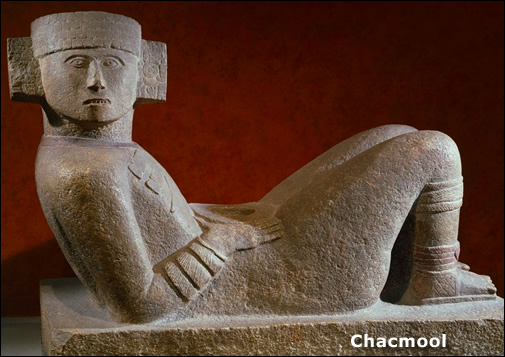Augustus and Alice Le Plongeon
How Two Well-Intentioned
Archaeologists Mangled
The Origins of History.
By Ron Fritze from Athens, Alabama
Posted on September 8, 2010
I am undecided whether Le Plongeon concocted these anecdotes from wishful fantasy or whether, as seems likely, he was so inept with spoken Maya that he simply misunderstood
much of what the Indians said. There is considerable evidence
favoring each of these possibilities.
— Robert Wauchope
Augustus Le Plongeon (1826-1908) was a controversial pioneer archaeologist who primarily worked on the Maya ruins of Uxmal and Chichen Itza in the Yucatan peninsula of Mexico during the 1870s and early 1880s. He and his wife Alice Dixon (1851-1910)
 accomplished much useful archaeological fieldwork, but their theory that the Maya were the originators of all human civilization, including Egypt and Atlantis, brought them into disrepute with the rest of the emerging archaeological profession.
accomplished much useful archaeological fieldwork, but their theory that the Maya were the originators of all human civilization, including Egypt and Atlantis, brought them into disrepute with the rest of the emerging archaeological profession.
Although born the son of a French naval officer, Augustus Le Plongeon would later come to consider himself a citizen of the United States. During his early life he traveled widely, particularly in the Americas, where he gained training in medicine, which allowed him to adopt the title of doctor. He also learned photography, a skill he put to good effect on his archaeological work, and developed an interest in American antiquities. While busy with these varied pursuits, Augustus managed to grow a long and flowing beard, perhaps to add some dramatis personae to his blossoming identity.
A Marriage Made for Archaeology
Meanwhile, in early 1873 the forty-seven-year-old adventurer married Alice Dixon, a lass of twenty-two from an English family living in Brooklyn. The newlyweds immediately launched their joint
 archaeological career, sailing for the ruins of Yucatán in July 1873.
archaeological career, sailing for the ruins of Yucatán in July 1873.
Augustus and Alice not only fell in love with each other, they also fell in love with the Maya civilization. It was a passion that distorted their objectivity and ability to think critically.
The Le Plongeons were assiduous recorders of details at the Maya ruins. Their greatest discovery occurred in 1875 when they uncovered the statue they named Chaacmool (Maya for powerful warrior) but later altered to Chacmool. Based on the Chacmool statue and other evidence from the ruins, Le Plongeon developed a version of Maya history going back ten or eleven thousand years and involving a Queen Moo, a Prince Coh, and others. This dating made the civilization of Queen Moo the oldest on earth and the source of all the others, or so Le Plongeon reasoned.
Atlantis Was a Colony of the Maya.
His theories and conclusions positioned Le Plongeon as an extreme diffusionist or hyper-diffusionist — just at the time when diffusionism was coming under increasing attack in scholarly circles. Like many of his contemporaries, Le Plongeon believed that Atlantis existed, but he was unique in that he considered it to be a colony of the Maya and not the other way around. He applied the same logic to Egypt, which he claimed was visited regularly by the Maya in the era before historical records.
These theories attracted much criticism to Le Plongeon, who stoutly defended his ideas. His spirited defense only caused the archaeological profession to ostracize him further.
Le Plongeon's flamboyant manner did not help his case. Many tales have circulated about him, and none bring credit to his reputation. He liked to tell a story about how he convinced his Maya workers that he was one of their ancient ancestors returned to this world by comparing his profile to a bearded figure on a bas-relief. The story has been widely doubted from the time Le Plongeon told it, but, in fact, it seems to have been largely true. Persistent rumors of his using dynamite on archaeological digs are also not true. It is also claimed that he believed that the ancient Maya had telegraphs when what he actually claimed was that they had prophesied the invention of telegraphy.
Jesus Spoke Maya.
Le Plongeon did, however, maintain that Jesus Christ actually spoke Maya from the cross and not Aramaic. He saw this “truth” as a particularly dramatic example of the supposedly widespread Mayan influence on the ancient world. Instead, it appeared in the realm of ideas as a ludicrous falsehood, one that made Le Plongeon look ridiculous.
Although the archaeological profession rejected the Le Plongeons' theories, other fringe groups did not. Later in life, Augustus and Alice developed close ties with the leaders of Theosophy, which did nothing to improve their scholarly reputations.
Augustus died in 1908 with his work ignored. Embittered about the way academics had treated them, Alice died two years later. According to a recent, sympathetic biographer of the Le Plongeons, if they had limited themselves to their factual archaeological fieldwork and had foregone speculation about the origins of civilization, they would be well and respectfully remembered as fine archaeologists.

Click on the black panther to read about Ron Fritze's latest book,
Invented Knowledge: False History, Fake Science, and Pseudo-religions.
|




 accomplished much useful archaeological fieldwork, but their theory that the Maya were the originators of all human civilization, including Egypt and Atlantis, brought them into disrepute with the rest of the emerging archaeological profession.
accomplished much useful archaeological fieldwork, but their theory that the Maya were the originators of all human civilization, including Egypt and Atlantis, brought them into disrepute with the rest of the emerging archaeological profession. archaeological career, sailing for the ruins of Yucatán in July 1873.
archaeological career, sailing for the ruins of Yucatán in July 1873.

